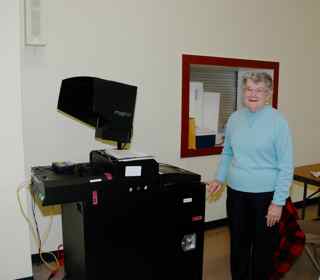Electronic voting is coming and it will be expensive
Posted November 10, 2008 by John T. Ryan
On Election Day Peru voters might have noticed a large black machine along one wall of St. Augustine’s Parish Center. This year the electronic voting machine was available for use by handicapped voters. Next November every voter will be using one of these machines. They will be deployed to each of Clinton County’s forty polling places. The change to these machines from the familiar lever operated mechanical machines is part of the federal government’s efforts to implement electronic voting systems throughout the United States.Last Tuesday in Peru, Election Inspector Beverly Uliva (larger photo) was on hand to explain how the ImageCast voting machine manufactured by Sequoia Voting Systems operates. She said voters would be given a paper ballot that they will take into a privacy booth to mark. After leaving the booth they will place the paper ballot into an optical scanning slot located at one end of the ImageCast machine. The machine will scan the ballot, tabulate the votes and store the paper ballot as a back-up record. Handicapped voters will use the opposite end of the machine. Computerized interfaces allow voters with mobility, physical, visual and hearing challenges to cast a ballot. (Click here for a demonstration of handicapped voting) (Click here for an explanation of both handicapped and non-handicapped voting)
Clinton County Election Commissioners Judith Layhee and Susan Castine said that the federal government is paying for the machines at a cost of $11,500 each. While the county will order the paper ballots, the cost will ultimately be billed to the towns. Although the exact cost hasn’t been determined Judith Layhee estimates the cost at approximately $.53 per ballot for paper and printing. New York State has only authorized one company to print the ballots so there’s no shopping for a better price. Computing the total cost gets very complex when you realize that Clinton County has approximately 46,000 registered voters and the percentage of voters actually casting ballots varies from year to year. Add to that the fact that voters can twice request to correct their ballot if they make an error. If the machine’s scanner malfunctions, Susan Castine said repairs will be attempted, but if it can’t be repaired the ballots will have to be hand-counted.
Statewide introduction of these machines has been further complicated because the firm New York State hired to test the machines has lost its federal certification. (Click here).
Posted: November 10th, 2008 under General News.

